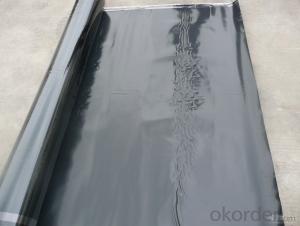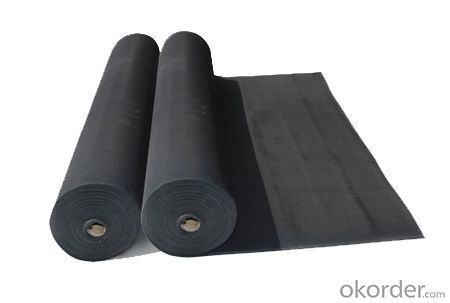EPDM Rubber Material Waterproof Membrane for Aquaculture
- Loading Port:
- Shanghai
- Payment Terms:
- TT OR LC
- Min Order Qty:
- 50000 m²
- Supply Capability:
- 5000000 m²/month
OKorder Service Pledge
OKorder Financial Service
You Might Also Like
EPDM Rubber Material Waterproof Membrane for Aquaculture
Description Of EPDM Rubber Material Waterproof Membrane for Aquaculture:
This waterproof coiled material is of high elasticity with best performance among high polumer waterproof coiled material in the world.It is also the most typical one in the world.Waterproof coiled material made of ternary ethylene-propylene rubber is produced with the use of the most advanced contiuous extrusion and vulcanization technology and related equipments which are specially designed for production of such product.It is good in compactness,without bubble and performance difference in length and breadth,perfomances reach or exceed the demands of GB18173.1-2000 standard.
Main Features of EPDM Rubber Material Waterproof Membrane for Aquaculture:
1.EPDM waterproof membrane for bridge engineering waterproof
2.EPDM waterproof membrane for water conservancy projects ,such as river bank,lake dam seepage.
3.EPDM waterproof membrane for the municipal engineering.
4.EPDM waterproof membrane for aquaculture.
Specifications of EPDM Rubber Material Waterproof Membrane for Aquaculture:
| Number | Item | Unit | Value | |
| 1 | Size Variation | Thichness | % | ±10 |
| Width | % | ±1 | ||
| Length | % | Allowed negative | ||
| 2 | Breaking tensile strength at normal temperature | Mpa | ≥7.5 | |
| Breaking tensile strength at 70°C | Mpa | ≥2.3 | ||
| 3 | Breaking elongation at normal temperature | % | ≥450 | |
| Breaking elongation at -20°C | % | ≥200 | ||
| 4 | Tear strength | KN/m | ≥25 | |
| 5 | Impermeability(30min) | * | 0.3Mpa no leakage | |
| 6 | Bending at low tempreture | °C | ≤-40 | |
| 7 | Stretch tensor at heating | Elongate | mm | ≤2 |
| Shrink | mm | ≤4 | ||
| 8 | Air oven aging(80°C×168h) | Tensile strength at break retained | % | ≥80 |
| Elongation at break retained | % | ≥70 | ||
| 9 | Anti-alkali | Tensile strength at break retained | % | ≥80 |
| Elongation at break retained | % | ≥80 | ||
| 10 | Nuture weathing at manual simulation | Tensile strength at break retained | % | ≥80 |
| Elongation at break retained | % | ≥70 | ||
Applications of EPDM Rubber Material Waterproof Membrane for Aquaculture:
Widely used in roofs, basement, toilet ,swimming pool, and all kinds of industry and civil building waterproofing, reservoir, vivicism, bridge, underground, tunnel and dam waterproofing ,especially to the keystone waterproofing projects which is durability, high corrosion resistance and easy deformation.



IMages of EPDM Rubber Material Waterproof Membrane for Aquaculture:




FAQ of EPDM Rubber Material Waterproof Membrane for Aquaculture:
1. What are we supplying?
We are specialized in producing Colorful Asphalt Roof Shingle, SBS/APP modified bitumen waterproof membrane, Self adhesive bitumen waterproof membrane, PVC waterproofing membrane, EPDM rubber roofing membrane, Single Component Polyurethane Waterproof Coating, and Spray Polyurea Waterproof Coating
.
2. How Many years experience do we have?
We have been exported to more than 20 countries in the past 15 years.
3. How long do we usually reply your request?
We always reply our customer within 24 hours.
- Q: Can a waterproofing membrane be used in conjunction with building code requirements?
- Indeed, the application of a waterproofing membrane can be utilized alongside the mandates of the building code. The building codes commonly necessitate sufficient safeguard against moisture, particularly in regions susceptible to water seepage like basements, bathrooms, and roofs. Waterproofing membranes are deliberately crafted to establish a barrier that thwarts water infiltration, thereby bestowing an extra shield against predicaments stemming from moisture such as leaks, mold, and structural deterioration. Through the adoption of a waterproofing membrane that satisfies or surpasses the prerequisites stipulated in the building code, constructors and contractors can guarantee adherence to the regulations while simultaneously bolstering the sturdiness and durability of the edifice.
- Q: Can a waterproofing membrane be used in mining or excavation projects?
- Indeed, mining or excavation projects can make use of a waterproofing membrane. Such membranes are specifically crafted to thwart the infiltration of water and other liquids, making them a perfect remedy for regions susceptible to water intrusion, such as mines or excavations. Typically, these membranes are fashioned from resilient substances like rubber or bitumen, and they are affixed to the walls, floors, or roofs of these structures to establish an impervious barricade. By employing a waterproofing membrane, mining and excavation projects can diminish the likelihood of water harm, safeguard equipment and infrastructure, and guarantee a secure working environment for laborers.
- Q: Can a waterproofing membrane be used on precast brass surfaces?
- No, a waterproofing membrane cannot be used on precast brass surfaces. Brass is a non-porous material, therefore it does not require waterproofing.
- Q: Can a waterproofing membrane be used for loading docks or ramps?
- Yes, a waterproofing membrane can be used for loading docks or ramps. A waterproofing membrane is designed to protect surfaces from water damage by creating a barrier that prevents water from seeping through. Loading docks and ramps are exposed to various weather conditions and can be prone to water infiltration, which can cause damage over time. Applying a waterproofing membrane to these surfaces can help to prevent water penetration, protecting the structure and increasing its lifespan. Additionally, a waterproofing membrane can also provide added benefits such as slip resistance, protecting against chemical spills, and reducing maintenance costs.
- Q: How does a waterproofing membrane handle freeze-thaw cycles?
- The ability to endure freeze-thaw cycles is a crucial characteristic of a waterproofing membrane. It must possess specific properties that allow it to expand and contract without compromising its integrity. Freeze-thaw cycles occur when water enters the membrane and freezes during colder temperatures, causing it to expand. When the ice melts during warmer temperatures, the membrane should be able to contract back to its original state. In order to handle freeze-thaw cycles, a waterproofing membrane typically possesses elasticity and flexibility. This enables it to adjust to the expansion and contraction without cracking or breaking. It may also have a low water absorption rate to prevent water from seeping into the membrane. Moreover, the membrane should exhibit excellent adhesion to the substrate to ensure it remains in place during temperature fluctuations. Certain waterproofing membranes incorporate special additives or technology to enhance their freeze-thaw resistance. These additives may consist of polymers or elastomers that enhance the membrane's ability to withstand extreme temperature changes. Furthermore, some membranes have reinforced layers or fabric inserts that provide additional strength and durability, making them better equipped to handle freeze-thaw cycles. All in all, a well-designed waterproofing membrane should effectively endure freeze-thaw cycles by possessing elasticity, flexibility, resistance to water absorption, and strong adhesion to the substrate. This guarantees the longevity of the membrane and prevents water infiltration, ultimately protecting structures from potential damage caused by freeze-thaw cycles.
- Q: Does a waterproofing membrane prevent water infiltration through concrete or other building materials?
- Yes, a waterproofing membrane is designed to prevent water infiltration through concrete or other building materials. It acts as a barrier, effectively sealing off the surface and protecting the underlying structure from water damage.
- Q: Can a waterproofing membrane be tested for quality or performance?
- Yes, a waterproofing membrane can be tested for quality and performance. Several tests can be conducted to evaluate the effectiveness and durability of the membrane. One common test is the water penetration test, where the membrane is subjected to a certain amount of water pressure to determine if it allows any water to pass through. Another test is the adhesion test, where the strength of the membrane's bond to the substrate is evaluated. Additionally, tests can be conducted to assess the membrane's resistance to chemicals, UV radiation, temperature fluctuations, and physical stress. These tests help determine if the membrane meets the required standards and can perform effectively in various conditions.
- Q: Can a waterproofing membrane be used on brick block surfaces?
- Brick block surfaces can indeed benefit from the application of a waterproofing membrane. These membranes are widely used to create a barrier against water infiltration and safeguard buildings from moisture damage. When applied correctly, they effectively seal brick block surfaces, safeguarding against water penetration and promoting the structure's longevity and durability. Acting as a protective layer, the membrane prevents water from seeping into the bricks and causing issues like deterioration, cracking, or mold growth. It is crucial to choose a waterproofing membrane specifically designed for brick block surfaces and meticulously follow the manufacturer's instructions for proper application. Moreover, seeking guidance from a professional contractor experienced in waterproofing is highly recommended to ensure optimal outcomes and long-term performance.
- Q: Can a waterproofing membrane be used on stainless steel surfaces?
- Indeed, stainless steel surfaces can benefit from the application of a waterproofing membrane. Stainless steel, a resilient and non-corrosive material widely utilized across different industries, is not impervious to water damage or corrosion, particularly in severe conditions. By applying a waterproofing membrane onto stainless steel surfaces, an extra shield against moisture is established, effectively warding off potential water damage, rusting, and corrosion. To guarantee optimal adhesion and durable protection, it is crucial to ensure the compatibility of the waterproofing membrane with stainless steel and its correct application.
- Q: What is called a waterproof roll dry shop, wet shop
- The biggest difference between the two is the same bonding strength, wet pad bonding strength is much larger than the dry shop method.
Send your message to us
EPDM Rubber Material Waterproof Membrane for Aquaculture
- Loading Port:
- Shanghai
- Payment Terms:
- TT OR LC
- Min Order Qty:
- 50000 m²
- Supply Capability:
- 5000000 m²/month
OKorder Service Pledge
OKorder Financial Service
Similar products
Hot products
Hot Searches
Related keywords

































